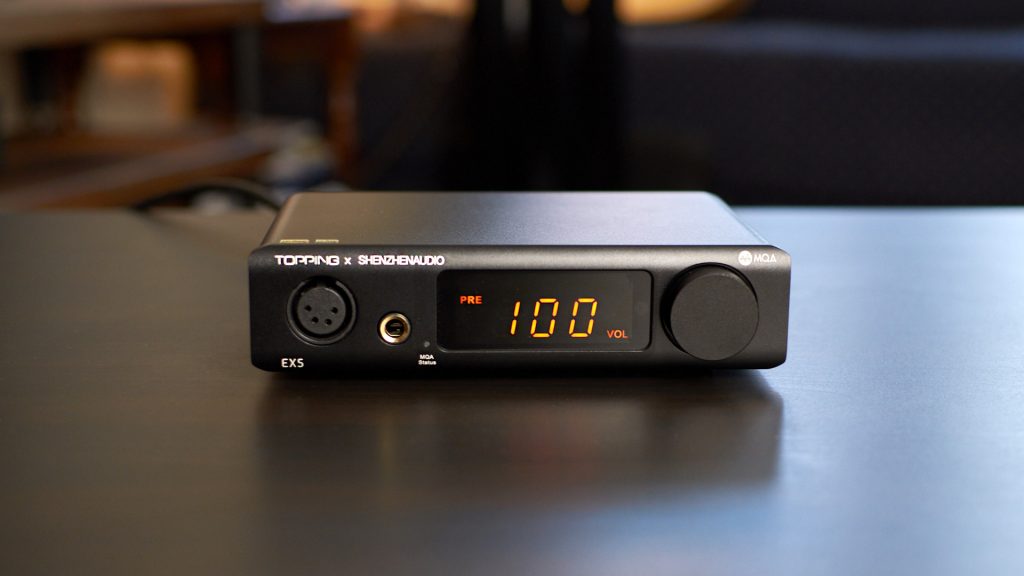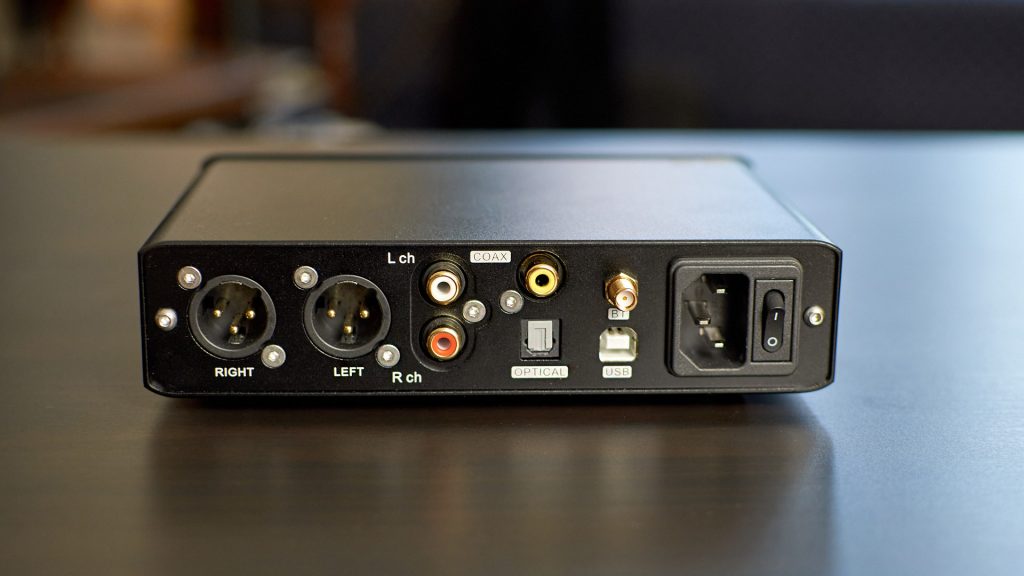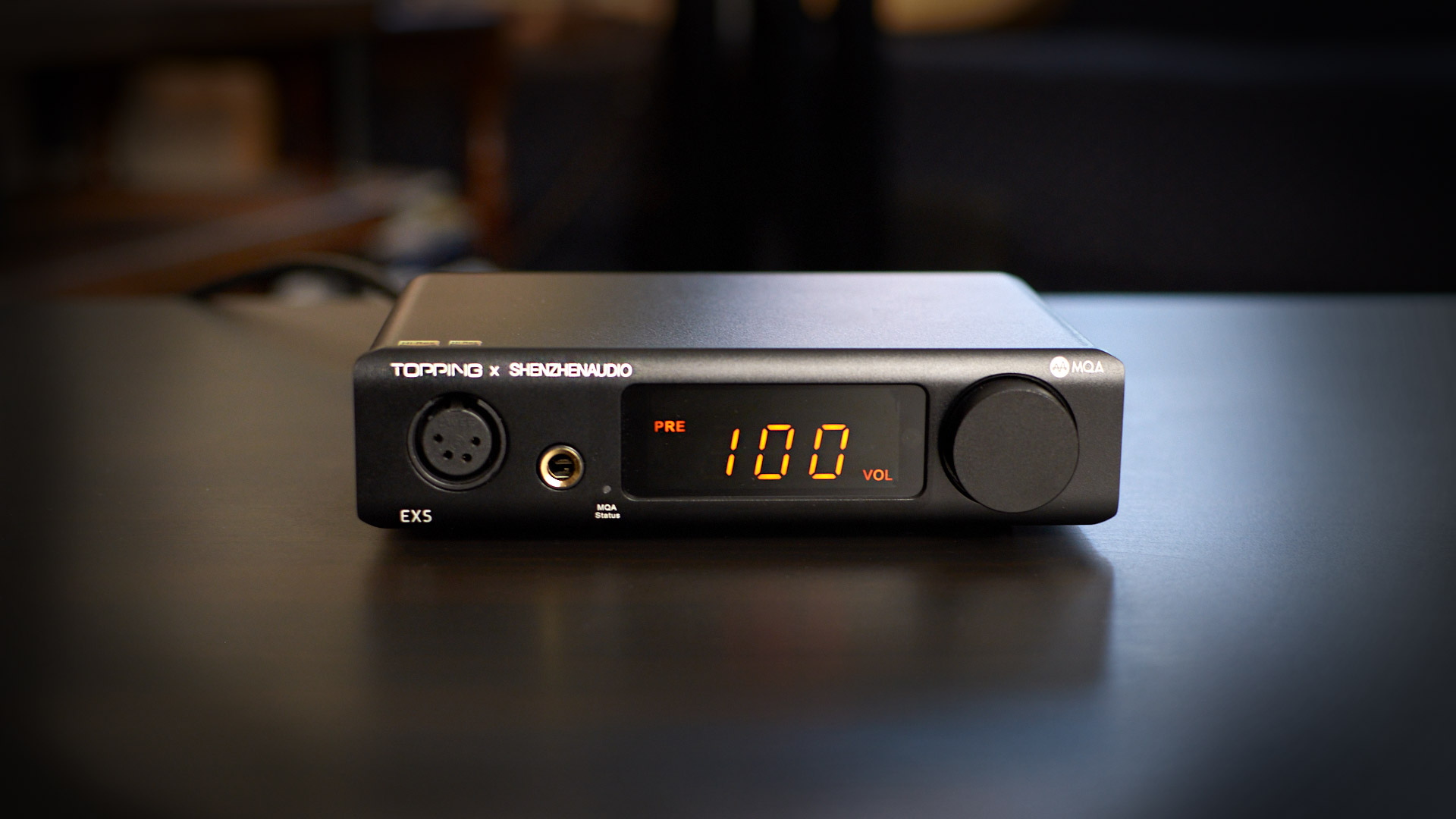Topping EX5 is the latest DAC and Head-Amp combination from the brand, and it occupies their midrange offering with a reasonable price of 349 USD. This time around, Topping joined forces with an online audio gear retailer ShenzhenAudio to create this unit. I’m not sure in which capacity is ShenzhenAudio involved in this project, and if this is going to affect the usual Topping traits. To find it out, I’ll be putting this mid-ranger through its paces, so let’s start.
Build and Connectivity
Taken out of the box, EX5 is a typical Topping product and I mean it in a good way. It’s made completely out of aluminium, it feels solid and looks like a quality piece of gear. On the back of the unit, we find a usual trio of digital inputs: USB, Coaxial, and Optical. There’s also Bluetooth connectivity onboard, hence the small BT antenna that’s removable if you don’t want to use this function. As for the analog outs, you can choose between single-ended RCA and balanced XLR ones. The unit is powered directly from the mains, so there is no external power brick this time.
In the front, we find an LED display with big and easily readable orange digits. To its right there’s a volume knob that doubles as a button, so you can browse the settings with it. On the left side of the unit, we find two different headphone outs, a 6.3 mm single-ended one (6.3 mm to 3.5 mm adapter is supplied in the box), as well as a balanced XLR one. A remote control is also included and it’s a typical Topping affair, meaning it’s small, made out of plastic, but functional enough if you aim straight at the device.

Specs and Features
For the complete spec list, you should take a look at the table down at the end of this review. That said, let’s mention a few of the more interesting details. The DAC part of the device is based on dual ESS ES9038Q2M Sabre DAC chips, and all the formats you can imagine are supported. Full decoding of the infamous MQA is present over USB input too, which is something that’s usually interesting only to Tidal streaming service users.
On the amplification side of things, we have Topping’s NFCA modules capable of outputting up to 1300 mW on each channel, and up to 18.3 Vpp. This should be enough for almost all headphones out there. There’s a gain switch with two positions, Low and High, making it easier to adapt the gain to any particular model.
Finally, there’s a preamp function on EX5 which basically means that you can adjust the volume level even on its RCA and XLR outs. That said, you can opt to use a headphone out only, RCA only, XLR only, or RCA and XLR both at the same time. As you can see, there is no combining headphones out with any of the pre-outs, it’s one or the other.
Sound (Headphones Out)
I started my testing with headphones, using mostly Hifiman HE-4XX, Verum 1, and Sendyaudio Aiva, but there were some others too, including sensitive in-ears. Topping EX5 proved to be a powerful amp with slightly warmer tonality. This means that the bassline is somewhat emphasized, but it goes deep and punches well. The midrange is clean and detailed but on the safe side of things. And the same laid-back character applies to the highest spectrum too, it will never sound overly sharp or aggressive. This type of tonality makes EX5 a very pleasant listen, even for the longer runs.
Dynamics are good and EX5 has a reasonable kick in it. Full and punchy bassline helps that impression, and I doubt that anybody would ever feel wanting more on this front. When it comes to the soundstage, it’s not particularly wide, but there is a decent sense of depth to be heard. Layering and separation of the instruments are very decent too.
Pairing (Headphones)
Topping EX5 is not particularly choosy when it comes to headphones. Due to its more than reasonable power reserves, it drove everything I threw at it with ease. Moving to very sensitive in-ears didn’t present any problem either, so no background noise or any sort of hum ware detected. The only thing to care about here is matching the tonality of your headphones with EX5’s. Emphasized baseline and laid-back upper part of the spectrum mean that I would avoid pairing it with dark-sounding models. Everything else, ranging from neutral to brighter should match just fine.
Sound (Line Out)
Next, it was time to test Topping EX5 as a DAC in my room setup. To my surprise, that darker tonality mentioned in the section above wasn’t observable on line-outs. Here it sounded more as I came to expect from a Topping to sound – tonally neutral with flat frequency response and plenty of high-frequency details. Unfortunately, it was a bit flat in terms of dynamics, so don’t expect a particularly punchy or full sound here. The soundstage is reasonably wide, but there is not much depth to talk about. It’s more or less in line with what you’d expect from a cheaper Topping E30 or D50s, and not at the level of dedicated DAC units at this price. With EX5 being a two-in-one unit, that is reasonable to expect really.

Comparisons
Loxjie D30 is half the price of EX5 and with lower power reserves. If you don’t need much power, it’s still a worthy contender. The bassline on Loxjie D30 is not as punchy, but the midrange is more open and more forward sounding, so I enjoyed vocals through it more. The highest spectrum is also airer, making the soundstage slightly wider and more open. EX5 on the other hand sounds more focused and punchier.
Topping E30 and L30 stack is more neutral in its presentation, but more analytical sounding with more emphasis on the higher frequencies. EX5 is once again punchier, with more bass emphasis. This duel boils down to taste more than anything else.
SMSL SU-8s and SH-8s stack sounds clearly more open and resolving. There are more details to be heard, transients are faster, the air between the instruments is much more obvious. That said, this combo is tonally very bright and if not matched carefully it can easily become tiring. It costs more too.
Topping D30 Pro and A30 Pro are in for an all-around win. These are even more powerful, with the deep but very grippy bassline. Base notes contain more details and texture too. Up the frequency spectrum, and we have quicker sound with greater detail retrieval in general. Unlike the SMSL stack, this one is keeping things neutral and natural, without emphasizing any part of the spectrum. It’s not a competition really, EX5 sounds bloated and closed in direct comparison. But at half the price it’s not really something to be held against it.
If we’re talking about line-outs, as previously mentioned, EX5 is roughly in line with what E30 and D50s offer. This means that it can not reach the levels of dynamics and sound separation that D30 pro can, or SMSL SU-8s for example. These dedicated DACs are better at their job, but by choosing them you’d be forgoing a very capable headphone out that EX5 offers.
Conclusion
Competition in this segment is strong and there are plenty of options to choose from, including the ones from the same manufacturer. But I feel that Topping judged its value well and priced it accordingly. EX5 is a decent DAC and head-amp with little to complain about if you’re fine with its slightly darker tonality.
| TOPPING EX5 – CHARACTERISTICS |
|
Dual ESS ES9038Q2M SABRE DAC Chips |






I have an SP200 would you use the EX5 as a Dac Or the E50 as a Dac. Or what Dac would work, I look at the su-9 or the su-8s would like it with MQA
I would go for E50 or SU-8s, both are great and better than DAC section in EX5.
Is there a difference between these two su-9 or the su-8s and how about the Loxjie D50 whit AK4499 chipset
SU-9n is a bit warmer in the bassline but otherwise they sound very similar and I think that 8s is a better bang for the buck.
I haven’t try Loxjie D50 but Loxjie always offer great value, so it might be a really good idea.
Hello! I have an Active Speaker. If I’m looking for a DAC, EX5 or DX5 do I choice?
Or another price DAC Could you recommend to me?
I need MQA. Thank you.
another same price DAC* sorry